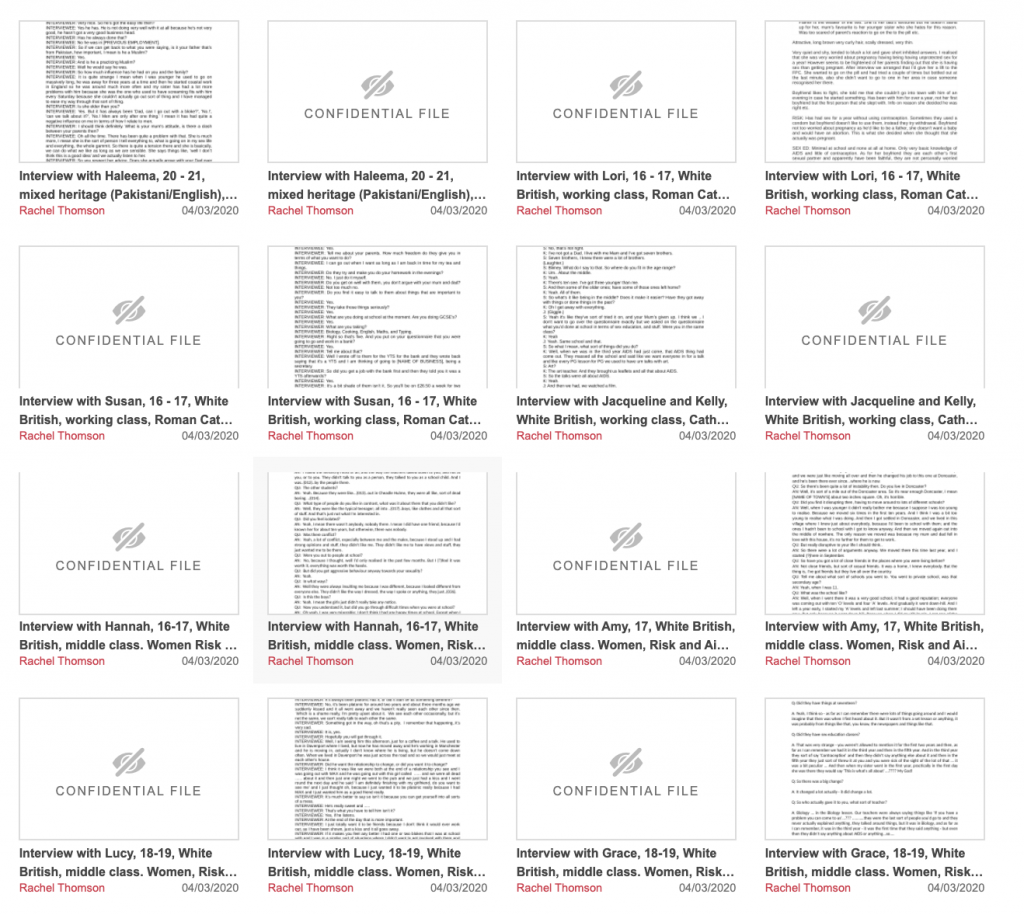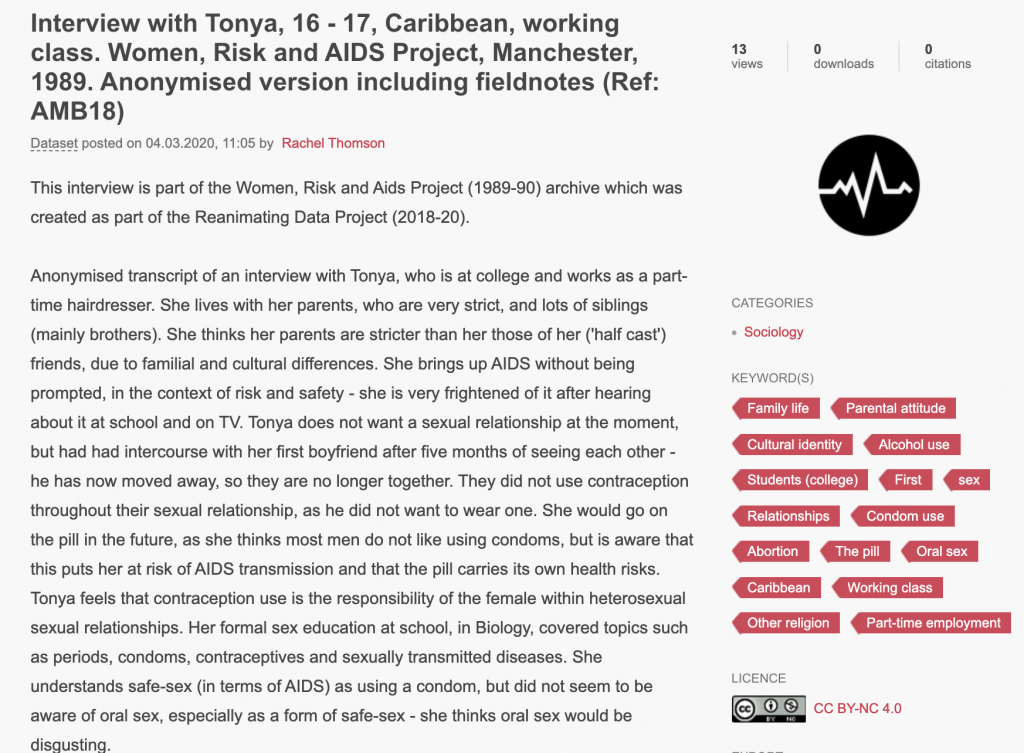Rosie Gahnstrom
Most of my last year has been spent on my sofa, watching daytime TV and preparing the Women, Risk & AIDS Project (WRAP) interviews to be published in a digital archive – my day to day hasn’t changed much at all in light of Covid-19 (apart from the added anxiety of worrying about the health and safety of everyone in the entire world, the plummeting economy and the precarity of academia and its dwindling job market, a.k.a my future prospects).
My role in the Reanimating Data team has been to format, anonymise and catalogue all of the meta-data for the interviews and their accompanying field notes. Much of this has been fairly mundane, ritualistic and monotonous – open document, select all, change font to Arial, size 11, justify margins, adjust margins, insert, page number (top of page, Plain Number 3), find all double spaces, replace all double spaces with single spaces. The trickier, more interesting bits have been treating the data with a feminist ethics of care. Simple, I thought. I just need to give each interviewee a pseudonym and redact any identifying information. We’ve been taught a fairly generic, blanket rule of adhering to ethics like this, but I’d never really had the chance to properly engage with and reflect on these principles.

I had tried to be completely objective when changing the names of research participants. I had a list of ‘Popular baby names 1970s UK’ open on Google, and once I’d exhausted those would stare longingly at my book shelf, mentally scouring stories for names that might fit the stories being told in each interview. Naming each interviewee couldn’t really be objective – there’s too much tied up in a name, and assumptions around social class, ethnicity, place, time, gender. Which names would the original interviewees have picked for themselves? What a certain name might mean to me most likely has totally different connotations for someone else. AMD18, for example, I had named Tonya. On reflection, I think I had been struggling to think of any new names, but had recently seen ‘I, Tonya’ with Margot Robbie, where Tonya Harding (whose life the film is based on) was born in 1970 – just the right age for a WRAP participant. Rachel, PI for the project, said that she wouldn’t have chosen Tonya for that particular interviewee. There’s lots of literature on the importance of naming in social science research (Moore, 2012 – The politics and ethics of naming, for example), and I’m sure I could quite happily write an entire dissertation on the topic.

Archiving the dataset for public use raises a whole host of other ethical issues, too – does informed consent obtained in the late 1980s still count today? Could any of the original research participants ever have imagined that the archive would be taken out of a box in someone’s garage and uploaded onto the internet for anyone to stumble across? Would they want the intimate thoughts of their younger selves out there for themselves to find? – I still can’t decide whether I would like the goings on of my teenage years and the way that I would have framed them then to be known by anyone now, other than maybe my therapist.
Of course, any potential identifying information from each interview has now been anonymised or redacted. Originally, this had meant working with some key principles for anonymising the data, but in practice it didn’t feel right to be as consistent as that. Names of places, parent’s job roles, bands and musicians that young women listened to became [NAME OF TOWN], [CARING PROFESSION], [COUNTRY SINGER]. How much of these young women’s stories are woven into the industrial town in northern England that them and their parents, and probably their parent’s parents grew up in, and the opportunities that had been afforded to them there, and how much context do we lose when we omit these? These are all different parts of these young women’s lives that have, to some extent at least, shaped the way that they think about their sexual identities or how they position themselves against the opposite sex.
Anonymisation principles used by the Reanimating Data team.
- Change all people’s names (in CAPS). This includes the name of the interviewee, any partners, friends, family members etc. This is the only ‘fake’ information we will include.
- Where a participant gives their name, change this and create a pseudonym. Where they don’t do this, don’t create a pseudonym.
- Put all new text / changes in caps.
- Remove names of schools, workplaces and colleges. Do not replace these with made up names. Instead put [school] [company] etc.
- Leave all place names and details of neighbourhoods where possible. Where a participant has moved around or where the combination of different places feels identifiable change these. Do not make up alternative places but replace with [town] [city] etc. Or make specifics more generic. E.g. ‘Singapore and Hong Kong’ can be replaced with ASIA.
- Change details of locations and jobs for third parties (parents, partners) unless seems highly relevant.
One particularly tricky interview to work with was Amanda’s, or LSFS23 as she had been known for some time. Amanda had unfortunately been through an incredibly traumatic sexual experience in her home country before moving to London in the late 1980s. She went into quite a lot of detail about this in her interview and it felt significant for her story to be told, and to be heard. After much consultation with Rachel, Niamh and Sue Sharpe, who had originally interviewed ‘Amanda’, we decided that it was important to keep more than the bare bones of her story alive. Redacting some of the finer details of what had happened, and the names of countries, of work colleagues, of slang terms particular to where Amanda had grown up, felt like enough. We know through the wake of the #MeToo movement that there is power in storytelling, but of course we don’t know whether ‘Amanda’ would still want her story to be heard, and how she would want it to be told. Omitting the entire experience felt like silencing her, which happens far too much to women in society more generally, so I hope that we have done enough here to retain the eloquence and bravery with which Amanda’s story had originally been told.
The Women, Risk and AIDS Project had been conducted in both London and Manchester yet publications that came out of the study blurred any geographical differences, identifying young people only by their age, gender and social class, rather than by their location. Reading the data now I notice striking differences between the data from each of these places. There are different norms and youth sub-cultures operating in the different cities, and in different places within each city. Growing up in Brighton, my own adolescence was spent outside Borders on a Saturday afternoon during my ‘emo’ phase, in Saltdean park with a bottle of Glenn’s vodka on a Friday night, shortly graduating to club nights like Shameless at Audio on a Thursday or Pound Dance at Digital on a Wednesday. These are some of the places that helped shape my identity as a teenager.
The concept of place had been an important way of framing the Reanimating Data project. We have chosen to work with just the Manchester data and to work with community groups in the city to ‘rematriate’ some of the original data – to give it back to the city and communities it was abstracted from. In anonymising the data, we have clearly labelled each interview and fieldnote as ‘Manchester’ or ‘London’, offering the opportunity for future researchers to explore the significance of place to these young women’s lives, relationships and sexualities. Through anonymising the data and employing a feminist ethic of care we’ve had to remove many of the details of the streets, neighbourhoods, clubs and areas of Greater Manchester that the young women evoke. It feels almost sad that some of the defining parts of the WRAP young women’s stories (their Friday nights spent in Saltdean park making some questionable choices concerning boys in the year above) are lost through the anonymisation process, and that a new generation of researchers are unable to explore how, why and in what ways place might have mattered to them in forming their own sexual identities.
What we have made possible is that current and future researchers can now read these stories which have been handled carefully – twice. Once in 1989 and the early 1990s by the team of WRAP researchers and again in 2019 and 2020 by a new team of feminist researchers trying to balance our desire to both protect these young women from unwanted exposure or harm, whilst ensuring that the stories they chose to tell are still being heard.
INTERVIEWEE: What do you hope to gain from this research?
Interview with Lucy (MAG18) for the Women, Risk and AIDS Project.
INTERVIEWER: I think we hope to be able to give young women themselves some kind of voice in terms of the sorts of things they find difficult or important or are concerned about. And to have some kind of input and feedback into health education. Some people design the leaflets and posters all the time, but they don’t necessarily talk to the people who are supposed to be reading them about what is important to them.
INTERVIEWEE: Will it go back into like sex education in schools do you think?
INTERVIEWER: We hope so yes. Because sex education in schools is pretty rudimentary and most people we have talked to say what you said. Something like it’s about babies and it wasn’t very helpful. It’s trying to say something about that. And more general things about how women feel about relationships and sexual relationships in particular, and what’s important. Generally nobody asks you, so we would like to do that so there will be a number of different things that we hope to relate to that and of course it should have been explained to you already …………..so you don’t need to worry about that, but we would like to think that the women we interview might actually read some of the things we write.
INTERVIEWEE: You actually write in magazines?
INTERVIEWER: Well we might do, we haven’t, but we think that might be quite a good idea to do that……….. not about…..so you might see something about it in Nineteen ……….
To download and read the anonymised material visit the archive here. And if you don’t know where to start? Here’s Tonya’s interview.
